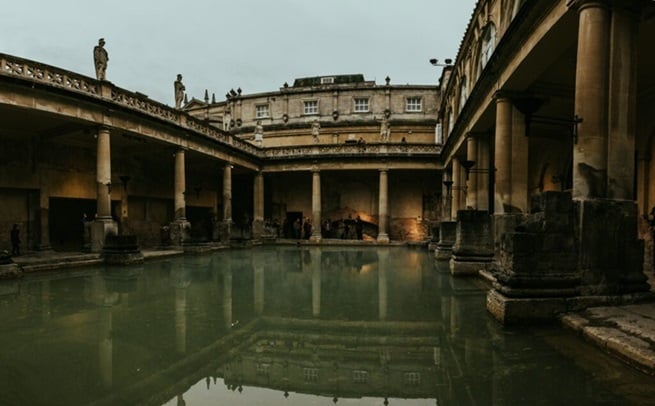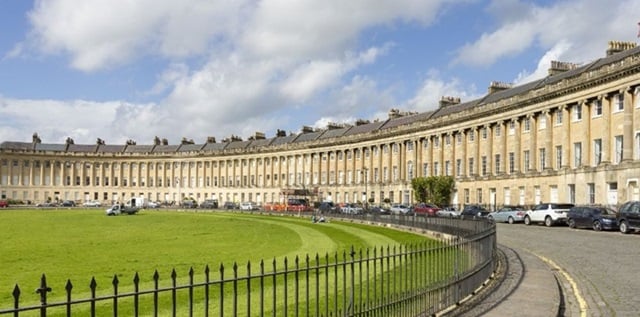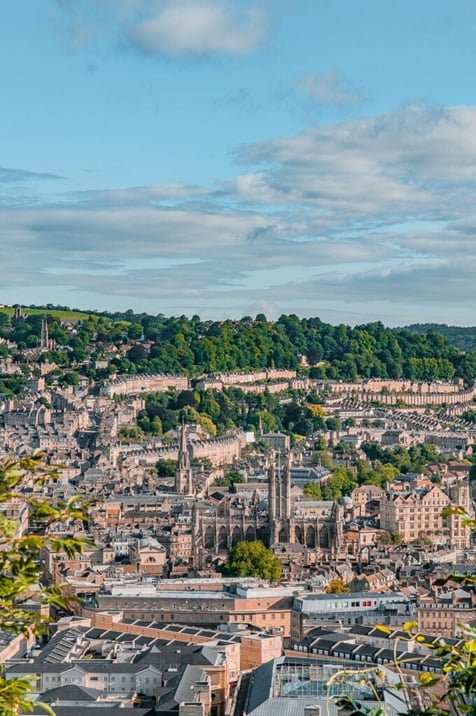The entire city of Bath is a World Heritage Site. Why not make the trip and find out exactly why it enjoys this honour? Let’s explore what to do in Bath!
- Roman Baths
- Pump Room Restaurant
- Royal Crescent
- The Jane Austen Centre
- Holburne Museum
- Pulteney Bridge
- Bath from above
- Prior Park
Roman Baths
The Roman Baths are what Bath is best known for, after all, they did give the city its name! Located in the heart of the city centre, on Stall Street. These buildings were constructed in 70AD and the colonnades, changing rooms and plunge pools remain superbly preserved to this day. You can walk around almost all areas of the complex and can still drink the (rather pungent) water should you wish to!
Do you want a spa break in the city? Then you can do so at the nearby modern Bath Thermae facility, which offers a variety of services and treatments.

Pump Room Restaurant
In the Roman Baths complex, you’ll find the Pump Room, which is now a restaurant. Beneath the incredible chandelier, and surrounded by the fountains and Corinthian columns, you can enjoy champagne brunch or afternoon tea. It typically opens for evening dining during the summer months, when you can enjoy a carefully selected menu inspired by seasonal ingredients.
The Pump Room features prominently in Jane Austen’s books Persuasion and Northanger Abbey. Fans of the novelist might find the Pump Room little changed from her descriptions. Austen described it as the place where ‘every creature in Bath was to be seen in the room at different periods of the fashionable hours’.
Royal Crescent
The Baths and the Crescent are perhaps the two most iconic buildings in the city. Many other spa towns around the UK have their own versions of the Crescent, but Bath’s is the original, and the others are mere copies!
Located on the edge of Royal Victoria Park, in the northwest of the city. Bath’s Royal Crescent was constructed in the 18th century and must be one of the finest Georgian buildings anywhere in the world. It’s 150 metres long and originally comprised 30 homes. Many of the buildings in this Grade I listed structure are still exclusive private homes today. Walk along with them and look at who is commemorated by the blue plaques. Some of the other houses are now used for other purposes, for example, you’ll find the Museum of Georgian Life at No 1 The Crescent.
For more fine examples of Georgian townhouses, head down the road to The Circus. At different times, artist Thomas Gainsborough and actor Nicholas Cage have both lived here.

The Jane Austen Centre
On Gay Street, one of the roads radiating from The Circus, you can find out how the city inspired Jane Austen’s writing. You can also find out what life was like here in the Regency period and dress up in some costumes of the day.
Holburne Museum
Located in Sydney Pleasure Gardens, towards the northern end of the city centre, this Grade I listed Georgian building houses a fine collection of art from the Dutch Masters, alongside some wonderful sculptures, porcelain and embroidery. It also hosts world-class exhibitions, such as the six-month-long Canaletto in Venice display in 2021.
Pulteney Bridge
This 18th-century bridge over the River Avon, designed in the Palladian style, is one of the few bridges anywhere in the world to have buildings across its entire span.
The bridge, and the horseshoe weir that lies beneath it, are perhaps best viewed from the nearby landscaped gardens, as many small, quirky individual shops are located on the bridge, and when you walk across it, you might not even realise you are on a bridge.
Fans of Les Miserables might notice that Pulteney Bridge was the location for one of the key scenes in the 2012 film when a character jumped to his death in the river.
Regular boat trips down the Avon leave from the bridge.
Bath from above
One of the best ways to see the city is from an aerial view. The six-mile Bath Skyline is a walking route devised by the National Trust and traverses the downs and woodlands to the east of the city centre. The route goes via Sham Castle, Bathwick Wood, Bathampton Down, Claverton Down, Rainbow Wood Fields, Widcombe Hill, Smallcombe Vale and Bathwick Hill.
There’s also a great view of Bath as you approach from a southerly direction along the Kennet and Avon Canal.
Alternatively, visit Bath Abbey and take the tour to the top of the 50-metre-high tower.

Prior Park
Just off the Skyline route, you’ll find this 18th-century National Trust landscape garden. It was created by local entrepreneur Ralph Allen, with advice from the legendary ‘Capability’ Brown, and is home to 28 acres of lakes, water features, woodland and meadows. Perhaps the highlight is the Palladian Bridge, yet another of the city’s many Grade I listed structures.
A good location is a key to an enjoyable visit to Bath, so browse our serviced apartments for the best combination of comfort and convenience.

